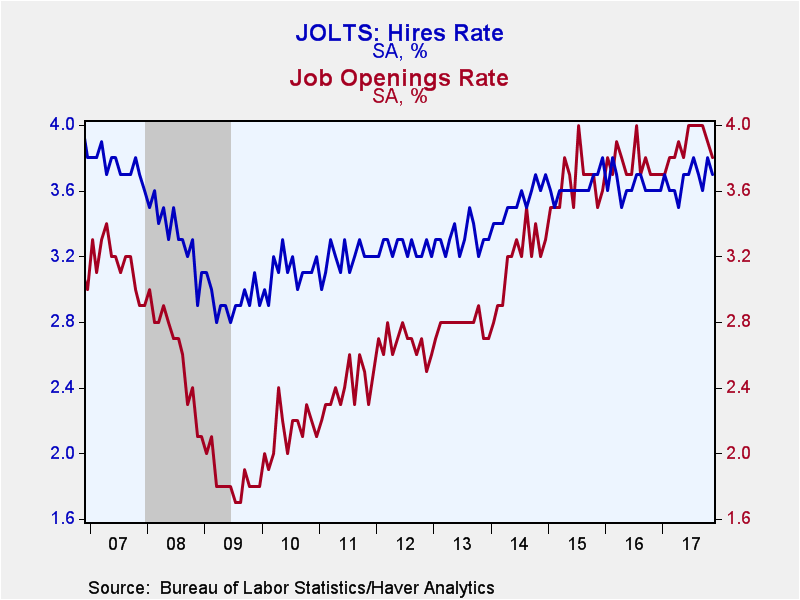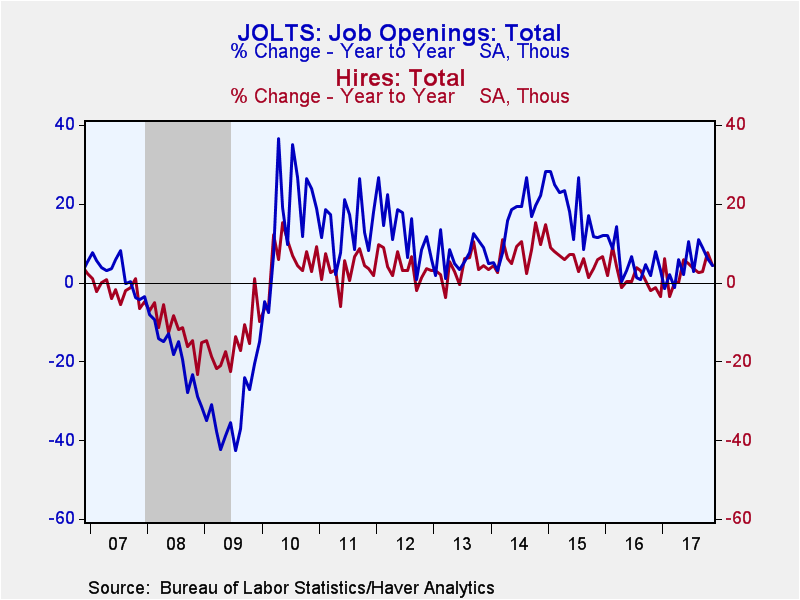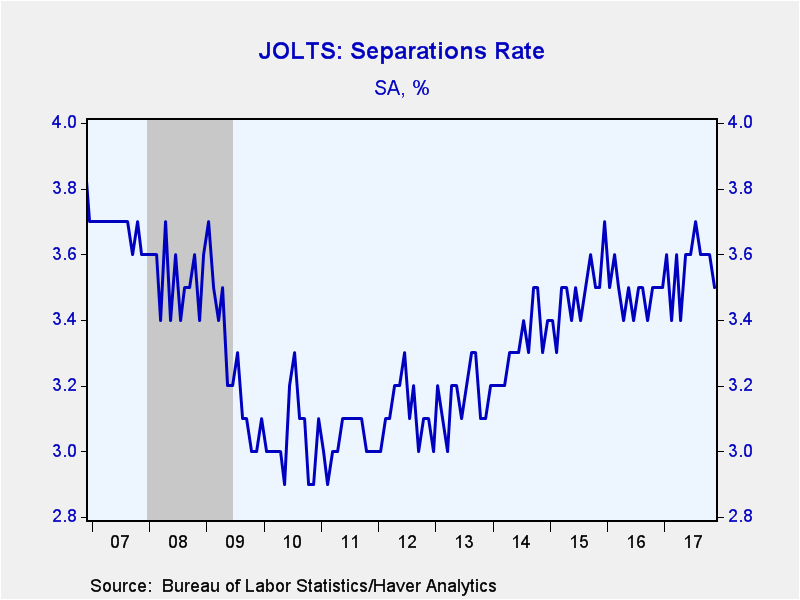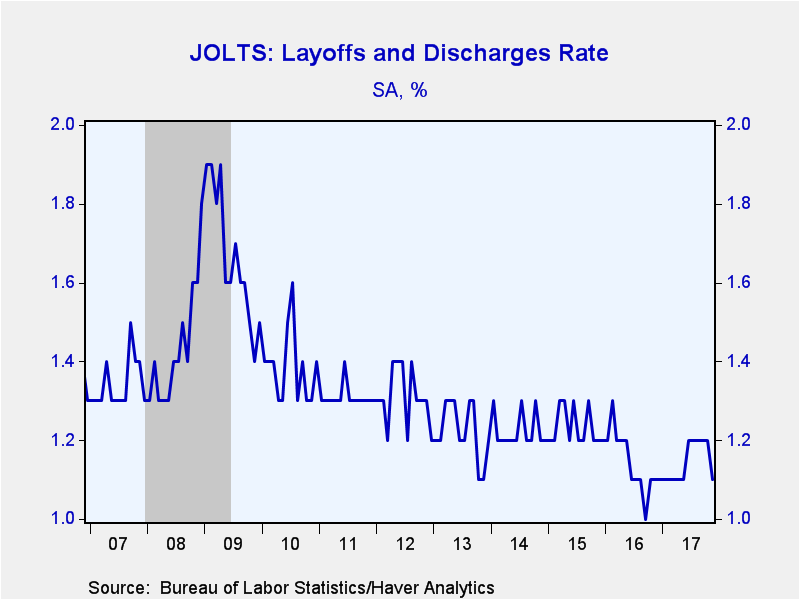 Global| Jan 09 2018
Global| Jan 09 2018U.S. JOLTS: Job Openings and Hiring Rates Erode
by:Tom Moeller
|in:Economy in Brief
Summary
The Bureau of Labor Statistics reported that the total job openings rate in November fell to 3.8%, its lowest level in six months. The hiring rate also fell slightly to 3.7% from the expansion high of 3.8%. These figures are from the [...]
The Bureau of Labor Statistics reported that the total job openings rate in November fell to 3.8%, its lowest level in six months. The hiring rate also fell slightly to 3.7% from the expansion high of 3.8%. These figures are from the Job Openings & Labor Turnover Survey (JOLTS), which dates back to December 2000.
The private sector job openings rate fell to 4.1% from 4.2%. The decline was pronounced in the factory sector and professional & business services. The rate improved in leisure & hospitality as well as trade, transportation & utilities and construction. In health care & government, the rate held steady.
The total number of job openings eased 0.8% (+4.4% y/y) reflecting a 0.9% drop (+6.0% y/y) in the private sector total. The job openings decline included the manufacturing, professional & business services and health care & social assistance sectors. The number of job openings rose in construction, trade transportation & utilities and leisure & hospitality.
The private sector hiring rate slipped from the cycle high to 4.1% led by the construction, professional & business services and leisure & hospitality sectors. Elsewhere, the hiring rate rose moderately or held steady.
The overall number of hires fell 1.9% (+4.3% y/y), with sharp declines in leisure and hospitality, construction and professional & business services. Hiring improved in manufacturing, education & social services and government.
The overall job separations rate eased to 3.5%, the lowest level since April. The decline was led by the financial activities, construction, information, professional & business services and education sectors. The leisure & hospitality, manufacturing and trade transportation & utilities areas showed improvement.
The layoff & discharge rate declined to 1.1%, the lowest level in six months. The decline was evident in the professional & business services, financial services and education sectors. Layoffs & discharges increased amongst manufacturing, information as well as leisure & hospitalitys firms. The actual number of discharges eased 0.4% (+1.6% y/y) to the lowest level in six months. Professional & business service sector layoffs declined, but firing rose in manufacturing, trade, transportation & utilities and the leisure & hospitality sector.
The JOLTS survey dates to December 2000 and the figures are available in Haver's USECON database.
| JOLTS (Job Openings & Labor Turnover Survey, SA) | Nov | Oct | Sep | Nov '16 | 2016 | 2015 | 2014 |
|---|---|---|---|---|---|---|---|
| Job Openings, Total | |||||||
| Rate (%) | 3.8 | 3.9 | 4.0 | 3.7 | 3.7 | 3.6 | 3.3 |
| Total (000s) | 5,879 | 5,925 | 6,177 | 4.4% | 3.1% | 12.1% | 28.1% |
| Hires, Total | |||||||
| Rate (%) | 3.7 | 3.8 | 3.6 | 3.6 | 43.6 | 43.5 | 42.4 |
| Total (000s) | 5,488 | 5,592 | 5,320 | 4.3% | 1.2% | 5.8% | 8.2% |
| Layoffs & Discharges, Total | |||||||
| Rate (%) | 1.1 | 1.2 | 1.2 | 1.1 | 13.7 | 14.8 | 14.7 |
| Total (000s) | 1,686 | 1,693 | 1,746 | 1.6% | -4.8% | 2.8% | 2.3% |
Tom Moeller
AuthorMore in Author Profile »Prior to joining Haver Analytics in 2000, Mr. Moeller worked as the Economist at Chancellor Capital Management from 1985 to 1999. There, he developed comprehensive economic forecasts and interpreted economic data for equity and fixed income portfolio managers. Also at Chancellor, Mr. Moeller worked as an equity analyst and was responsible for researching and rating companies in the economically sensitive automobile and housing industries for investment in Chancellor’s equity portfolio. Prior to joining Chancellor, Mr. Moeller was an Economist at Citibank from 1979 to 1984. He also analyzed pricing behavior in the metals industry for the Council on Wage and Price Stability in Washington, D.C. In 1999, Mr. Moeller received the award for most accurate forecast from the Forecasters' Club of New York. From 1990 to 1992 he was President of the New York Association for Business Economists. Mr. Moeller earned an M.B.A. in Finance from Fordham University, where he graduated in 1987. He holds a Bachelor of Arts in Economics from George Washington University.










